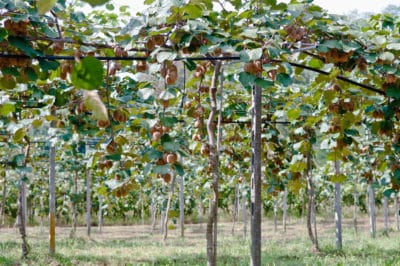Growing Kiwifruit
Kiwifruit are available in two types: fuzzy-skinned fruits the size of an egg and grape-sized smooth fruits. Although both will grow well in USDA Zones 7 to 9, the smaller versions are much more hardy and may extend the range into Zone 3. All need well-drained soil, plenty of water and regular fertilizer during the growing season. Like grapes, they also need annual pruning.
Choosing Kiwifruit Varieties
You have many choices for kiwifruit cultivars. Fuzzy-skinned kiwifruit must have male pollinator plants. The first three are fuzzy-skinned Actinidia deliciosa and the rest are hardy, smooth-skinned Actinidia arguta:
- Hayward
- Bruno
- Blake
- Ananasnaya or Anna
- Meader
- Ken’s Red
- 74-49.
Pruning Kiwifruit
The trellis supports the weight of the vine, but the plants must be properly pruned. Each plant needs a single trunk to the top of the trellis. At this point, the vine is trained into two single branches running to each end of the trellis. Side branches – think of a fish’s backbone – grow from the main leader to the side on top of the wires. Don’t let vines twine on the wire; it will cut into the vine.
T-Shaped Trellis
The T-shaped trellis is probably the most common style used for kiwifruit. Strong metal or wooden T-shaped posts are sunk deeply into the ground. Bury the posts by at least 1/3 of the total height – a 12-foot post should be sunk four feet deep. Wire is strung along the tops of the T-posts to the next post. Galvanized, high tensile 12-gauge wire is usually the best choice.
Vertical Posts
Like grapes, kiwifruit are often grown on a trellis that consists of vertical posts with about four or five feet above the ground. This system generally does not have crosspieces. Wires are strung from one post to another. The end posts should be solidly anchored and braced at each end to counteract the effect of tension from the wires. Kiwifruit vines are very heavy due to their length and massive leaf canopy.
Trellis Problems
The most common problem in trellising kiwifruit is trellis failure. This usually occurs because you didn’t bury the posts deep enough or anchor them adequately. In windy areas especially, the leaf mass acts like a sail. Wet soil and the sheer weight of the vines can bring down a trellis. Wooden posts should be treated to prevent rot.
